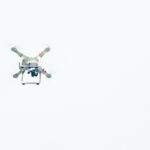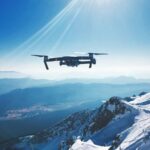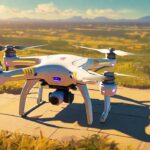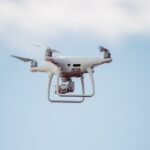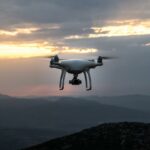In an era characterized by rapid technological advancements, few innovations have captured the imagination quite like drones. These unmanned aerial vehicles have revolutionized industries ranging from photography and agriculture to delivery and inspection. As technology continues to evolve at an astonishing pace, it becomes imperative to stay up-to-date with the latest advancements in drone technology. In this article, we will explore the cutting-edge developments that are shaping the future of drones, unraveling the thrilling possibilities that lie ahead.

Latest Advancements in Drone Technology
Drones have come a long way since their inception, and they continue to push the boundaries of innovation. With breakthroughs in autonomy, battery life, payload capacity, and safety features, the latest advancements in drone technology promise to revolutionize various industries. Let’s dive into the exciting developments that are shaping the future of drones.
1. Autonomy Takes Flight
One of the most significant strides in drone technology is the growing autonomy of these unmanned aerial vehicles. Drones are now capable of flying without direct human intervention, thanks to advancements in artificial intelligence and machine learning. Imagine the possibilities when drones can navigate complex environments, avoid obstacles, and make decisions on their own. The synergy between humans and autonomous drones opens up new frontiers in fields like delivery services, surveillance, agriculture, and mapping.
“Autonomy in drones is propelling us towards a future where these flying robots can accomplish tasks with remarkable precision and efficiency.”
2. Enhanced Battery Life
Aircraft endurance has always been a critical limitation for drones. However, cutting-edge battery technologies are changing the game. Researchers and manufacturers are developing next-generation batteries that significantly improve flight time. With extended battery life, drones can remain airborne for longer periods, making them more efficient for various applications. Whether it’s capturing stunning aerial footage, conducting search and rescue missions, or delivering essential supplies to remote areas, drones equipped with advanced batteries are extending their usefulness.
“Imagine the limitless possibilities when drones can perform tasks that require extended flight time, transcending the limitations of traditional aircraft.”
3. Increasing Payload Capacity
Drone technology continues to expand its payload capacity, enabling them to carry heavier loads. This development is essential for sectors like logistics, where drones are increasingly used for deliveries. With the ability to transport larger and more substantial packages, drones are becoming more viable for last-mile delivery services. Additionally, industries such as construction and agriculture benefit from drones that can carry specialized equipment or sensors to analyze data, increasing efficiency and productivity.
“The growth in payload capacity revolutionizes industries, providing an agile and cost-effective means of transporting goods and equipment.”
4. Advancements in Safety Features
Ensuring the safety of drones and the surrounding environment remains a top priority. Consequently, significant advancements have been made in safety features. Drones are now equipped with technologies like collision avoidance systems, geo-fencing to prevent unauthorized flights, and improved data encryption. These features not only enhance drone safety but also foster public trust and acceptance. Moreover, regulations and industry standards play a pivotal role in consolidating safety practices and ensuring responsible drone usage across the globe.
“The integration of safety features establishes drones as reliable and secure tools, fostering trust and facilitating their integration into our everyday lives.”
Conclusion
The latest advancements in drone technology are paving the way for a future where drones are integral to various industries. From their enhanced autonomy to improved battery life, increased payload capacity, and upgraded safety features, drones have surpassed expectations and continue to push boundaries. As drones become more versatile, affordable, and widely adopted, their potential in sea, air, and space applications is limitless. Keeping up with the ever-evolving landscape of drone technology is not only exciting, but it also ensures that we remain at the forefront of this remarkable innovation.
“Embrace the possibilities as drones soar into new realms, transforming the way we live, work, and explore.”
Drones have revolutionized various industries, from photography to delivery services. Whether you are a hobbyist or a professional, it’s essential to stay updated with the latest information about drones. If you’re curious to learn more about drones and their various applications, check out this informative resource on our website: Info about Drones. Discover how drones are transforming the world and explore the fascinating possibilities they offer. Don’t miss out on this opportunity to expand your knowledge and dive into the exciting world of drones. Click here to access the resource now!
FAQ
Question 1
What are some of the latest advancements in drone technology?
Answer 1
The latest advancements in drone technology include the development of more autonomous drones capable of flying without direct human intervention. Drones now use composite materials like carbon fibers for their bodies, making them lightweight, cost-effective, and strong. Next-generation batteries are being developed to improve flight time, while payload capacity has increased, allowing drones to carry heavier loads. Future advancements also include hybrid aerial robotics, air-ground drones, long flight drones with smart technology batteries, and VTOL (Vertical Take-off and Landing) drones with high accuracy.
Question 2
What sectors are adopting drones worldwide?
Answer 2
Drones are being adopted across various sectors, including military, commercial, personal, and future technology. They have proven to be valuable tools in military applications, aiding in surveillance, intelligence gathering, and even combat operations. In the commercial sector, drones are being used for tasks like aerial photography, delivery services, and inspection of infrastructure. Drones also have a significant presence in the personal sector, with enthusiasts using them for recreational purposes, videography, and photography. Additionally, the future potential of drones extends to sectors like sea, air, and space.
Question 3
What are some notable advancements in drone technology over the years?
Answer 3
Advances in drone technology have been substantial over the years. Notable advancements include enhanced autonomy, integration of artificial intelligence, expansion of drone delivery services, swarm technology, improved battery life and charging solutions, and enhanced safety and security features. Drones have become more capable and versatile, allowing for a wide range of applications. The National Academies and the American Society of Mechanical Engineers (ASME) provide valuable resources and information on these improvements and advancements in drone technology.
Question 4
What is the historical background of drones?
Answer 4
Drones have been around for more than two decades, with their roots dating back to World War I when unmanned airplanes were first developed. Since then, drone technology has significantly advanced, fueled by the need for military and commercial applications. In recent years, there has been a considerable growth in drone adoption and increased usage across various industries. This has led to a greater global awareness of drones and their potential to revolutionize numerous sectors.
Question 5
What are the key areas of focus for drone advancements?
Answer 5
The key areas of focus for drone advancements include durability, flight time, payload capacity, automation, and safety features. Manufacturers are continually improving the durability of drone materials to withstand harsh conditions and impact. Extending flight time is another significant focus, with the development of more efficient batteries and power management systems. Increasing payload capacity enables drones to carry heavier loads, expanding their range of capabilities. Automation plays a crucial role in improving the ease of operation and reducing the reliance on human intervention. Lastly, safety features like collision-avoidance systems and improved navigation technologies are being incorporated into drones to enhance their overall safety and reliability.

